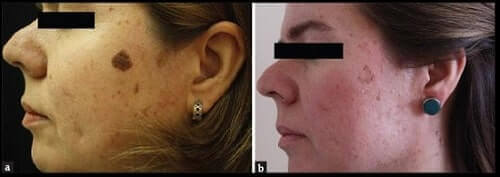Dermatosis Papulosa Nigra (DPN) are common in people with dark skin, especially in African Americans. Perhaps the most famous person with these mole like protuberances on his face is actor Morgan Freeman. DPNs tend to appear on the face, neck and upper torso regions most frequently.
DPN Overview
DPN lesions generally emerge during puberty and usually have a genetic hereditary propensity (similar to seborrheic keratoses). They typically occurs in individuals with Fitzpatrick skin types III to VI. Therefore, people of South Asian and African heritage tend to have higher occurrence rates of Dermatosis Papulosa Nigra. Women are also more likely to have Dermatosis Papulosa Nigra.
DPN is considered to be a common variant of seborrheic keratoses (SKs). It was first described in 1925 by Dr. Aldo Castellani, based on his observations while visiting Jamaica and Central America. DPN papules (bumps) appear as 1 to 4 mm brown or black dots that resemble moles. They tend to increasing steadily in number and size as a person ages, with spontaneous regression highly unlikely. The DPN marks are almost always benign and noncancerous, with no treatment required. However, people may wish to remove them if they find them to be cosmetically undesirable.
One study found that people with darker skin who used skin lightening creams tended to have a larger number of DPN bumps. This could be due to reduced UV ray protection from the loss of protective skin pigment melanocytes.
Dermatosis Papulosa Nigra Removal

DPN removal options include the following surgical and non-surgical methods:
- Scissor excision via snipping.
- Cryotherapy. Liquid nitrogen is generally used to freeze off the bumps. However, in people with darker skin, cryotherapy can cause hypopigmenation or hyperpigmentation due to potential damage of melanocyte cells.
- Curettage. A dermatologist will scrape off the bumps with a small surgical instrument.
- Electrocautery. An electric current runs through a small probe with a fine needle electrode tip. This current burns (cauterizes) the DPN skin tissue, but does not pass through the patient’s body.
- Electrodesiccation. A professional will zap the bumps with a low electric current using a probe. Topical anesthesia is usually applied before this treatment. This procedure (also called fulguration) uses heat from the electric current to pass through and destroy the abnormal DPN tissue.
- Laser Therapy. Among lasers that have been used to successfully remove Dermatosis Papulosa Nigra in patients include: potassium titanyl phosphate (KTP) lasers; pulsed dye lasers (PDL); Nd:YAG lasers; Q-switched and picosecond lasers; and CO2 lasers. In general, the Nd:YAG 1064 nm wavelength lasers are the most suitable for people with dark skin. However, talk to your dermatologist to see which is best for your type of skin.
Scarring, dyspigmentation, skin discoloration, greying, crusting, and keloid formation are potential complications that can arise after Dermatosis Papulosa Nigra removal. Note that DPN lesions can always recur after treatment with any of the above modalities.
DPN versus Seborrheic Keratoses
Dermatosis Papulosa Nigra (DPN) is considered to be a common variant of seborrheic keratoses (SKs). However, a recent report denoted some major differences between the two.
- While DPN affects darker skin types, SKs are far more common in lighter-pigmented individuals with Fitzpatrick skin type I to II.
- DPN lesions are largely limited to sun-exposed areas of the body (face and neck). In contrast, SKs have a more widespread distribution.
- Morphologically, DPN lesions are relatively small and uniform. SKs on the other hand vary widely in size and shape. Some seborrheic keratosis diameters can reach several centimeters in size.
- While DPN and SKs genetically share a common somatic activating mutation (FGFR3), DPN lacks the mutation in PIK3CA that is found in SKs.
Post Treatment Care
After treatment, one must take a number of precautions. Sun exposure should be kept at a minimum, and always after application of sunscreen. Do not pick at your lesions and treated areas, even if their is significant itching. Try not to use any kinds of creams, makeup, acid containing products or other potentially harmful lotions with chemical ingredients.